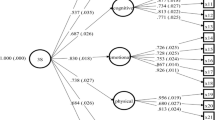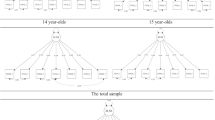Abstract
The assessment procedures and psychometric properties of the How I Feel (HIF), an instrument used to assess psychological well-being in a population of Black adolescents are described. The audiovisual mode of presentation obviates problems related to reading skill; in addition, it standardizes the administration of the instrument. The How I Feel appears to measure reliably and validly several multi-item constructs representing psychological well-being. These constructs relate to other instruments and constructs in meaningful and interesting ways. A major result of our validity studies is that there appear to be two major components of psychological well-being, psychopathology and self-esteem.
Similar content being viewed by others
References
Bradburn, N. M. (1969).The Structure of Psychological Well-Being, Aldine, Chicago.
Bradburn, N. M., and Caplovitz, D. (1965).Reports on Happiness, Aldine, Chicago.
Brownlee, K. A. (1965).Statistical Theory and Methodology, Wiley, New York.
Bohrnstedt, G. (1974). Personal communication.
Campbell, A., Converse, P. E., and Rodgers, W. L. (1976).The Quality of American Life, Russell Sage, New York.
Cantril, H. (1965).The Pattern of Human Concerns Rutgers Univesity Press, New Brunswick, N.J.
Clausen, J. A. (1968). Values, norms, and the health called “mental”: Purposes and feasibility of assessment. In Sells, S. B. (ed.),The Definition and Measurement of Mental Health, U.S. Department of Health, Education and Welfare, Public Health Service, National Center for Health Statistics, Washington, D.C.
Connors, C. K. (1970). Symptom patterns in hyperkinetic, neurotic and normal children.Child Dev. 41: 667–682.
Coopersmith, S. (1967).The Antecedents of Self-Esteem, Freeman, San Francisco.
Crandall, R. (1973). The measurement of self-esteem and related constructs. In Robinson, P., and Shaver, R. (eds.),Measures of Social Psychological Attitudes, Institute for Social Research, Ann Arbor, Mich.
Cronbach, L. J. (1951). Coefficient alpha and the internal structure of tests.Psychometrika 15: 297–334.
Davis, J. (1962).Stipends and Spouses, University of Chicago Press, Chicago.
French, J. R. P., Jr. (1963). The social environment and mental health.J. Soc. Iss. 19: 39–56.
French, J. R. P., Jr. (1968). The conceptualization and measurement of mental health in terms of self-identity theory. In Sells, S. B. (ed.),The Definition and Measurement of Mental Health, U.S. Department of Health, Education and Welfare, Public Health Service, National Center for Health Statistics, Washington, D.C.
Gardner, E. A. (1968). Concepts of mental disorder. In Sells, S. B. (ed.),The Definition and Measurement of Mental Health, U.S. Department of Health, Education and Welfare, Public Health Service, National Center for Health Statistics, Washington, D.C.
Garmezy, N. (1974).The study of competence in children at risk for severe psychopathology. In Anthony, J., and Kouprinik, C. (eds.),The Child in His Family: Children at Psychiatric Risk, Wiley Interscience, New York.
Glidewell, J. C., Gildea, M. C. L., Domke, H. R., and Kantor, M. B. (1959). Behavior symptoms in children and adjustment in public school.Hum. Organiz. 18: 123–130.
Grinker, R. R. (1969). Psychiatry in our dangerous world. In Heseltine, G. F. D. (ed.),Psychiatric Research in Our Changing World, Excerpta Medica Foundation, Amsterdam.
Gump, J. P. (1972). Sex-role attitudes and psychological well-being.J. Soc. Iss. 28: 79–92.
Hodge, R. W. (1970). Social integration, psychological well-being and their socioeconomic correlates. In Laumann, J. O. (ed.),Social Stratification: Research and Theory for the 1970's, Bobbs-Merrill, Indianapolis.
James, W. (1890).Principles of Psychology, 2 vols., Holt, New York.
Kellam, S. G., Branch, J. D., Agrawal, K. C., and Ensminger, M. E. (1975).Mental Health and Going to School, University of Chicago Press, Chicago.
Lapouse, R., and Monk, M. (1958). An epidemiologic study of behavior characteristics in children.Am. J. Pub. Hlth. 48: 1134–1144.
Lord, F. M., and Novick, M. R. (1968).Statistical Theories of Mental Test Scores, Addison-Wesley, Reading, Mass.
Macfarlane, J. W., Allen, L., and Honzik, M. (1954).A Developmental Study of the Behavior Problems of Normal Children between Twenty-One Months and Fourteen Years, University of California Press, Berkeley.
Masterson, J. F., Jr. (1967).The Psychiatric Dilemma of Adolescence, Little, Brown, Boston.
Nowicki, S., Jr., and Strickland, B. R. (1972). A locus of control scale for children.J. Consult. Clin. Psychol. 36: 148–154.
Offer, D. (1969).The Psychological World of the Teenager, Basic Books, New York.
Offer, D., and Howard, K. I. (1972). An empirical analysis of the Offer Self-Image Questionnaire for Adolescents.Arch. Gen. Psychiat. 27: 529–537.
Pasamanick, B. (1962). Thoughts on some epidemiological studies of tomorrow. In Hoch, P., and Zubin, J. (eds.),The Future of Psychiatry, Grune and Stratton, New York.
Pasamanick, B. (1968). What's mental illness and how can we measure it? In Sells, S. B. (ed.),The Definition and Measurement of Mental Health, U.S. Department of Health, Education and Welfare, Public Health Service, National Center for Health Statistics, Washington, D. C.
Petersen A., and Kellam, S. (1976). The measurement of psychological well-being: A multimedia approach. Paper presented at the Annual Meeting of the American Educational Research Association, April, San Francisco.
Rosenberg, M. (1965).Society and the Adolescent Self-Image, Princeton University Press, Princeton, N.J.
Rosenkrantz, P., Vogel, S., Bee, H., Broverman, I., and Broverman, D. (1968). Sex-role stereotypes and self-conceptions in college students.J. Consult. Clin. Psychology 32: 287–295.
Sells, S. B. (Ed.). (1968).The Definition and Measurement of Mental Health, U.S. Department of Health, Education and Welfare, Public Health Service, National Center for Health Statistics, Washington, D. C.
Simmons, R. G., and Rosenberg, F. (1975). Sex, sex roles, and self-image.J. Youth Adoles. 4: 229–258.
Smith, M. B. (1959). Research strategies toward a conception of positive mental health.Amer. Psychologist. 14: 673–681.
Smith, M. B. (1968). Competence and “mental health”: Problems in conceptualizing human effectiveness. In Sells, S. B. (ed.),The Definition and Measurement of Mental Health, U.S. Department of Health, Education and Welfare, Public Health Service, National Center for Health Statistics, Washington, D.C.
Syngg, D., and Combs, A. (1949).Individual Behavior: A New Frame of Reference for Psychology, Harper, New York.
Author information
Authors and Affiliations
Additional information
Research presented in this paper is from the Social Psychiatry Study Center, Department of Psychiatry, University of Chicago and was supported by a grant from the National Institute on Drug Abuse (DA-00787).
Received her Ph.D. from the University of Chicago. Main research interests are biopsychosocial development in adolescence, especially for girls, and applications of statistical and psychometric methods to problems in longitudinal research.
Received his M.D. from University of Maryland. His psychiatric residency and research training was at Yale University and National Institute of Mental Health. Main research interests are long-term studies of social adaptation, psychological well-being (including psychopathology), and social structure and processes of the family and other social fields such as the psychiatric ward.
Rights and permissions
About this article
Cite this article
Petersen, A.C., Kellam, S.G. Measurement of the psychological well-being of adolescents: The psychometric properties and assessment procedures of the how I feel. J Youth Adolescence 6, 229–247 (1977). https://doi.org/10.1007/BF02138937
Received:
Issue Date:
DOI: https://doi.org/10.1007/BF02138937




